Introduction
We will look at common eye disorders in pets, preventive strategies, and when to seek expert treatment in this comprehensive guide to pet eye care. By the end of this article, you’ll be better prepared to keep your pet’s vision and overall quality of life.
Anatomy of Eye of a Pet

Every conscientious pet owner must understand the delicate structure of their pet’s eye. While the eyes of dogs and cats share many similarities with human eyes, there are also significant variances, and understanding these differences is essential for effective eye care.
The Cornea: The cornea, also known as the “window to the soul,” is the clear, outermost layer of the eye. This tiny structure acts as a translucent armor, protecting the inner ocular components from injury. Furthermore, it is responsible for bending and focussing incoming light, guiding it further into the eye, where it is processed for vision.
The Iris: The iris, which is the colored component of the eye, is located just behind the cornea and serves as the eye’s aperture. The iris, like a camera’s diaphragm, controls the quantity of light entering the eye by adjusting the size of the pupil. This dynamic process aids in maintaining excellent vision in a variety of lighting conditions.
The Lens: The lens is located just beneath the iris and functions as the eye’s lens system. It is in charge of fine-tuning incoming light and precisely directing it onto the retina, allowing the creature to comprehend their surroundings with clarity. The lens’s elasticity allows it to alter shape and focus on things at varying distances.
The Retina: This amazing layer borders the back of the eye and is essentially where vision magic happens. It contains rods and cones, which are light-sensitive cells. Cones detect colors and function in well-lit circumstances, whereas rods are responsible for low-light and peripheral vision. They work together to convert incoming light into nerve signals that flow to the brain via the optic nerve, generating the images our pets view.
The Optic Nerve: Known as the “cable” that connects the eye to the brain, the optic nerve is responsible for conveying nerve signals from the retina to the brain. This pathway is responsible for visual perception, helping our pets to perceive their surroundings.
The Conjunctiva: The conjunctiva is a thin, transparent membrane that covers the white of the eye and lines the eyelids. It acts as a guardian. It works as a protective barrier, preventing foreign objects and irritants from entering the eye. When you see your pet blinking or crying, it’s the conjunctiva’s natural defense mechanism protecting their eyes.
Common Eye Problems in Pets
Pets, like humans, can suffer from a variety of eye issues that require prompt diagnosis and treatment. These common eye disorders in pets can have a negative impact on their general health and well-being:
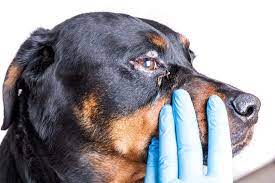
Conjunctivitis: Conjunctivitis, also known as “pink eye,” is an inflammation of the conjunctiva, a thin, transparent covering that covers the white area of the eye and lines the inside of the eyelids. This is one of the most common eye disorders in pets and can be caused by a variety of reasons, including allergies, infections (bacterial or viral), or irritants. Redness, heavy weeping, and ocular discharge are common symptoms. Conjunctivitis, if left untreated, can cause irritation and, in extreme cases, vision impairment.
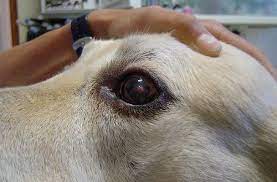
Corneal Ulcers: Corneal ulcers are lesions or abrasions to the cornea, the transparent, protective outer covering of the eye. They can happen as a result of foreign objects, scrapes, or other injuries. Corneal ulcers in pets are not only unpleasant, but they can also cause eyesight difficulties if left untreated. Identifying the indications, such as squinting, excessive blinking, and an eye that appears clouded or bluish, is critical for early intervention.
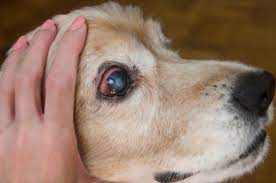
Cataracts: Cataracts are the clouding of the lens of the eye, which is frequent in older pets. This cloudiness prevents light from getting through the lens and onto the retina, causing visual impairment or even blindness. While cataracts are more common in senior pets, they can also be caused by heredity, diabetes, or eye injury.
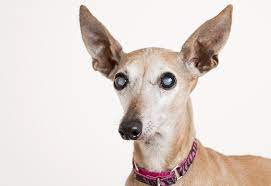
Glaucoma: Glaucoma is a disorder that causes increasing pressure within the eye. If left untreated, high intraocular pressure can cause extreme pain, visual nerve damage, and eventual blindness. Redness, squinting, and increased tearing are early indicators of glaucoma in pets. Regular eye exams are essential for early detection and management.
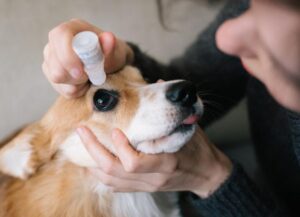
Dry Eye (Keratoconjunctivitis Sicca): Dry eye develops when the eyes of a pet do not generate enough tears to keep the eyes lubricated. This illness can cause pain, redness, and visual issues. Pets may excessively touch their eyes or show signs of ocular pain. Medicated eye drops are frequently used to promote tear production and reduce discomfort.
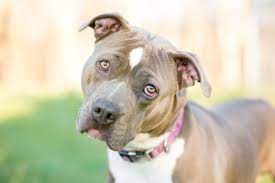
Eyelid Entropion and Ectropion: Eyelid entropion and ectropion are conditions in which the eyelids roll inward (entropion) or outward (ectropion). Entropion can cause the eyelashes to brush on the cornea, causing irritation and perhaps damaging the cornea. Ectropion can expose the inner lining of the eyelid, exposing it to discomfort and infection. Surgical correction is frequently required to address these issues.
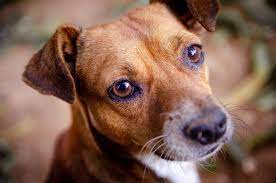
Uveitis: Uveitis is an inflammation of the uvea, which is the central layer of the eye. Trauma, infections, or systemic disorders can all cause this condition. It frequently manifests as redness, discomfort, and light sensitivity. Uveitis can be a sign of more serious health problems and should be treated as soon as possible to avoid future difficulties.
Pet Eye Care Preventive Measures
Preventive pet eye care procedures are the foundation for ensuring your animal buddy has a lifetime of good eyesight and ocular health. Here’s a more in-depth look at these critical steps:
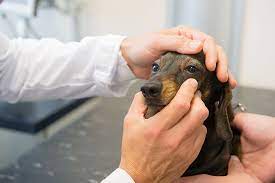
Regular Eye Exams: Just as regular doctor visits are necessary for people, scheduling regular check-ups with your veterinarian is vital for your pet’s eye health. Regular eye exams allow your veterinarian to spot any problems early, increasing the likelihood of effective treatment. These examinations also allow you to ask questions regarding your pet’s ocular health and address any concerns you may have.
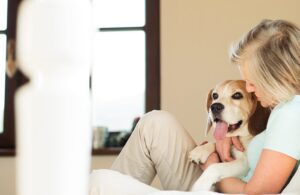
Maintain a Safe Environment: Your pet’s living place should be a safe refuge for their eyes. Remove any potential risks that could impair their vision. This involves removing any sharp items, chemicals, or plants that could cause discomfort or injury to the eyes. Make sure your pet’s environment is free of anything that could harm their eyes.

Proper Nutrition: A balanced diet is not only important for your pet’s overall health, but it also contributes to optimal eye health. Make certain that their meal contains critical elements such as vitamins and minerals. Fish oil contains omega-3 fatty acids, which can be especially useful for eye health and may help lessen the risk of some eye disorders.
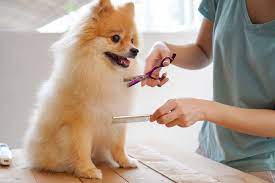
Grooming: To avoid irritation, keep the hair around your pet’s eyes well-trimmed. Long fur can cause irritation, discharge, and an increase in the risk of eye infections. Cleaning their eyes on a regular basis, especially in breeds prone to frequent tearing, can help avoid buildup and infections.

UV Radiation Protection: Just as too much sun exposure can hurt our eyes, certain pets are photosensitive. When your pet is outside, consider using pet sunglasses to protect their eyes, especially during high sunshine hours. Light-colored or hairless breeds are especially vulnerable to UV radiation’s harmful effects, and taking steps can help prevent problems like photokeratitis (sunburn of the eyes).
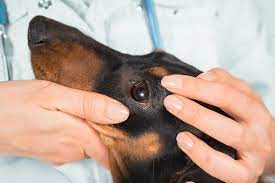
Preventing Eye Injuries: Because dogs and cats are inherently interested, they may find themselves in circumstances where eye injuries might develop. Be wary of sharp objects, chemicals, and potential eye risks in their environment. If your pet participates in sports or outdoor activities, consider utilizing protective eyewear.
First Aid For Pet Eye Injuries
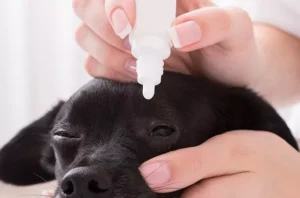
Every pet owner should be able to offer first aid for their pet’s eye damage. Here’s a full description of what to do if you have an eye injury:
Wash Their Eyes: If you find a foreign object in your pet’s eye, the first thing you should do is gently flush the eye with a sterile saline solution. This will aid in the removal of the object and any potential irritants. To avoid further harm, use a clean, lint-free cloth or gauze soaked in saline. Flush from the inner corner of the eye outward to avoid pushing the debris deeper into the eye.
Keep Them Calm: It’s critical to keep your pet as peaceful as possible throughout the procedure. To reassure them, hold them softly and speak soothingly to them. Pets can easily become upset when they perceive discomfort or anxiety, so keeping the surroundings quiet is critical to preventing the injury from worsening.
Cover the Eye: In cases of serious injuries, a clean, soft cloth can be used to cover the wounded eye. This improvised eye patch can shield the eye from further harm and lessen the likelihood of your pet scratching or rubbing it. However, avoid applying any pressure to the eye, as this might aggravate the condition.
Seek Veterinary Care: Even if the damage appears small after basic first aid, you must see your veterinarian. They are qualified to determine the extent of the injury and administer the necessary treatment. In some circumstances, what appears to be common eye disorders in pets conceals more serious underlying conditions, and prompt professional analysis is critical to ensuring the best outcome for your cat.
When to Seek Professional Assistance
Knowing when to seek professional assistance for your pet’s eye problems is critical to their ocular health. Here are some examples of when you should see a veterinarian or a veterinary ophthalmologist:
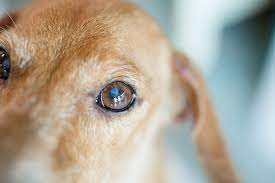
Any Ongoing Discomfort: If your pet shows evidence of ongoing discomfort, such as pawing at their eye, squinting, or displaying signs of pain, it is critical that you visit a professional. These actions could be a sign of common eye disorders in pets that need to be addressed right away. Constant discomfort can have a negative impact on your pet’s well-being and quality of life.
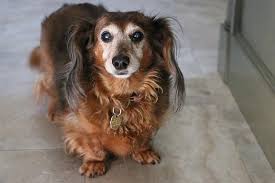
Abnormal Appearance: Any changes in your pet’s eye, such as cloudiness, abnormal discharge, or an unusual appearance, should not be overlooked. These can be symptoms of underlying diseases such as infections, cataracts, or corneal abnormalities. Early detection and treatment for pet eye issues are critical for avoiding future consequences.
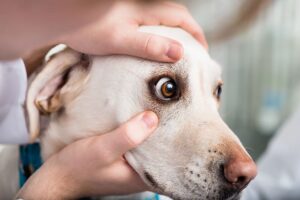
Sudden Blindness: A medical emergency exists if your pet experiences a sudden loss of vision. Glaucoma, retinal detachment, or trauma are just a few of the severe illnesses that can result in blindness. To establish the reason and commence proper treatment, a veterinarian or veterinary ophthalmologist must be consulted immediately.
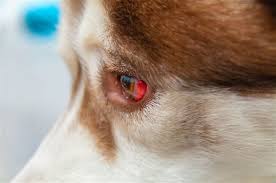
Trauma or Damage: Any major eye damage, whether caused by a foreign object, a conflict, or an accident, requires immediate treatment for pet eye issues by a professional. Corneal injury, lacerations, and even globe rupture can arise from eye trauma. Early evaluation is required to ascertain the extent of the injury and to avoid consequences.

Ocular Disease: If your pet has been diagnosed with a chronic ocular illness, such as glaucoma or cataracts, regular follow-up sessions are essential. Ocular illnesses may necessitate continual management and therapy modifications to maintain your pet’s ocular health and eyesight. Regular visits to a veterinary ophthalmologist ensure that the problem is properly monitored and treated as necessary.
Role of Veterinary Ophthalmologists
A veterinary ophthalmologist’s involvement is critical in the diagnosis and treatment for pet eye issues. Here’s a breakdown of everything you need to know about their job:
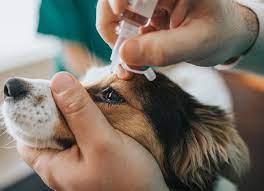
Medical Treatment: Veterinary ophthalmologists are highly qualified specialists who receive additional education and training to become experts in the diagnosis and treatment of eye disorders in pets. This specific knowledge is essential in dealing with the complexities of ocular health in a wide range of species, from dogs and cats to more exotic pets. Their comprehensive expertise in ocular anatomy, physiology, and pathology enables them to properly treat even the most difficult and rare eye disorders.
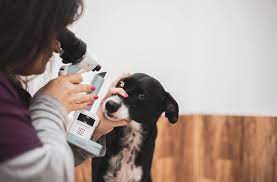
Diagnostic Instruments: Veterinary ophthalmologists have access to a wide range of cutting-edge diagnostic instruments and technology that are critical for accurate diagnosis and treatment. Slit lights, tonometers for detecting intraocular pressure, and electroretinography devices for evaluating retinal function allow for early diagnosis. These instruments provide vital insights into the anatomy and function of the eye, allowing for the detection of abnormalities that would otherwise be impossible to identify using standard veterinary equipment.